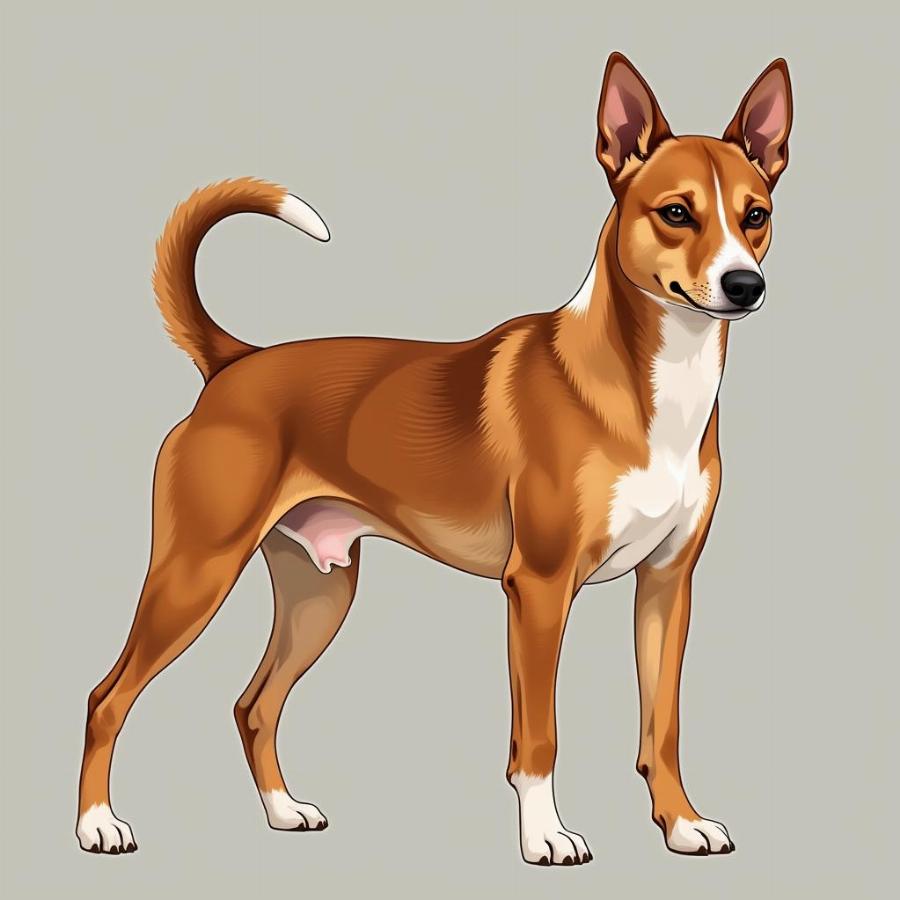The basenji dog, often referred to as the “barkless dog,” is a fascinating breed with a distinct personality and an intriguing “vector.” What exactly does “basenji dog vector” mean? In this comprehensive guide, we’ll explore the different facets that contribute to the basenji’s unique character, encompassing everything from their physical characteristics and temperament to their health considerations and training needs. Think of this “vector” as a combination of all the elements that make a basenji a basenji.
Understanding the Basenji’s Physical Vector: Appearance and Characteristics
The basenji’s physical “vector” is immediately recognizable. Their short, sleek coat, curled tail, and wrinkled forehead give them a distinctly regal appearance. They come in a variety of colors, including red, black, tri-color, and brindle. Their compact size makes them well-suited to apartment living, but their energy levels require regular exercise. What truly sets them apart, however, is their inability to bark. Instead, they communicate through a unique yodeling sound, adding to their mystique.
 Basenji Dog Physical Characteristics
Basenji Dog Physical Characteristics
Decoding the Basenji’s Temperament Vector: Personality and Behavior
The basenji’s temperament “vector” is just as unique as their physical appearance. They are known for their intelligence, independence, and strong-willed nature. They can be aloof with strangers but are deeply affectionate with their families. Their playful and curious nature makes them engaging companions, but their intelligence also means they can be mischievous if not properly stimulated. Early socialization and consistent training are crucial for a well-adjusted basenji.
Navigating the Basenji’s Health Vector: Common Concerns and Care
Understanding the basenji’s health “vector” is essential for responsible ownership. While generally healthy, basenjis are prone to certain genetic conditions, such as Fanconi syndrome, a kidney disorder. Regular veterinary checkups and a balanced diet are crucial for maintaining their well-being. Their short coats require minimal grooming, but their active minds need plenty of mental and physical stimulation.
Mastering the Basenji’s Training Vector: Tips and Techniques
Training a basenji requires patience and understanding of their independent nature. Positive reinforcement methods work best, as they are sensitive to harsh corrections. Their intelligence makes them quick learners, but their strong will can present a challenge. Consistency, early socialization, and engaging training techniques are essential for success.
Conclusion: Embracing the Complete Basenji Dog Vector
The “basenji dog vector” encompasses a fascinating combination of physical attributes, temperament traits, health considerations, and training requirements. Understanding these elements is crucial for anyone considering welcoming a basenji into their lives. By appreciating their unique characteristics, you can build a strong and rewarding bond with this extraordinary breed. Ready to embrace the adventure of basenji ownership?
FAQ: Addressing Common Basenji Questions
- Are basenjis truly barkless? Yes, basenjis are known for their inability to bark. However, they do make other vocalizations, such as yodels, whines, and growls.
- Are basenjis good with children? Basenjis can be good with children, but early socialization is key. Their playful nature makes them good companions, but supervision is always recommended.
- How much exercise does a basenji need? Basenjis are energetic dogs and require daily exercise, including walks, runs, and playtime.
- Are basenjis easy to train? Basenjis are intelligent but independent, which can make training challenging. Positive reinforcement methods and consistency are crucial.
- What are the common health concerns for basenjis? Basenjis are prone to certain genetic conditions, including Fanconi syndrome and hypothyroidism. Regular veterinary checkups are essential.
- Are basenjis good apartment dogs? Their size makes them suitable for apartment living, but their energy levels require regular exercise and mental stimulation.
- Do basenjis get along with other pets? Early socialization can help basenjis get along with other pets, but their prey drive may be a concern with smaller animals.
Further Exploration: More Basenji Resources
- Learn more about Basenji grooming tips. (Link to relevant article on Beaut Dogs)
- Explore different Basenji breeders. (Link to relevant article on Beaut Dogs)
- Discover the history and origins of the Basenji breed. (Link to relevant article on Beaut Dogs)
Beaut Dogs is your ultimate resource for all things related to dog breeds, including the unique Basenji. We offer expert advice and guidance on every aspect of dog ownership, from choosing the right breed to providing comprehensive care instructions. When you need support, contact us at Email: [email protected], and Beaut Dogs will provide detailed and accurate answers. Visit https://beautdogs.com today to explore the wonderful world of dogs!